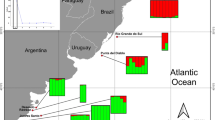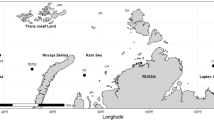Abstract
The upwelling systems along the coast of Morocco support some of the largest populations of sardine (Sardina pilchardus) in the world. Although these populations provide a base for a substantial fishing industry, virtually nothing is known about the genetic stock structure of this fish. Samples (n = 346), collected from seven sites along the Atlantic coast and in the Alboran Sea, were examined for exon-primed intron-crossing PCR (EPIC-PCR) polymorphism. Two markers, CaM-4 and Ops-1, had 6 and 9 alleles, respectively, after the pooling of gel fragments into 5 bp length classes, Correspondence analysis and the distribution of Fst among samples indicated that Moroccan populations were divided into two groups with Fst = 0.034 (P < 0.05) across the Gibraltar Strait. Populations along the Atlantic coast of Morocco comprise one genetic unit, except for a weak genetic boundary south of Cape Ghir and the peculiar behavior of the Safi sample would indicate a genetic drift. Complex ocean hydrodynamics around Gibraltar Strait and across Cape Ghir, likely, contributes to these genetic isolations. These results point out the usefulness of population genetic studies in stock management for sardine populations that may be particularly vulnerable to overexploitation especially during upwelling intensity shifts.



Similar content being viewed by others
References
Atarhouch T, Rami M, Cattaneo-Berrebi G, Ibanez C, Augros S, Boissin E, Dakkak A, Berrebi P (2003) New primers for EPIC amplification of intron sequences for fish and other vertebrate population genetic studies. BioTechniques 35:676–682
Atarhouch T, Rüber L, Gonzalez EG, Albert E, Rami M, Dakkak A, Zardoya R(2006) Signature of an early genetic bottleneck in a population of Moroccan sardines (Sardina pilchardus). Mol Phylogenet Evol (in press)
Aurelle D, Guillemaud T, Afonso P, Morato T, Wirtz P, Serrao Santos R, Cancela ML (2004) Genetic study of Coris julis (Osteichtyes, Perciformes, Labridae) evolutionary history and dispersal abilities. CR Biol 326:771–785
Bargelloni L, Alarcon JA, Alvarez MC, Penzo E, Magoulas A, Reis C, Patarnello T (2003) Discord in the family sparidae (Teleostei): divergent phylogeographical patterns across the Atlantic-Mediterranean divide. J Evol Biol 16:1149–1158
Begg GA, Waldman JR (1999) A holistic approach to fish stock identification. Fish Res 43:35–44
Belkhir K, Borsa P, Chikhi L, Raufaste N, Bonhomme F (1996–2004) GENETIX 4.05, logiciel sous Windows TM pour la génétique des populations. Laboratoire Génome, Populations, Interactions, CNRS UMR 5000, Université de Montpellier II, Montpellier (France)
Benzécri JP (1973) L’analyse des données Dunod, Paris
Berrebi P, Boissin E, Fang F, Cattaneo-Berrebi G (2005) Intron polymorphism reveals phylogeographic structure of Zacco platypus in China—a possible target for aquaculture development. Heredity 94:589–598
Bierne N, Lehnert S, Bédier E, Bonhomme F, Moore S (2000) Screening for intron-length polymorphisms in penaid shrimps using exon-primed intron-crossed (EPIC)-PCR. Mol Ecol Notes 9:233–235
Bierne N, David P, Boudry P, Bonhomme F (2004) Assortative fertilization and selection at larval stages in the mussels Mytilus edulis and M. galloprovincialis. Evolution 56:292–298
Borsa P (2002) Allozyme, mitochondrial DNA and morphometric variability indicate cryptic species of anchovy (Engraulis encrasicolus). Biol J Lin Soc 75:261–269
Borsa P, Naciri M, Bahri L, Chikhi L, Garcia de Leon FJ, Kotoulas G, Bonhomme F (1997) Zoogéographie infra-spécifique de la Mer Méditerranée. Vie Milieu 4:295–305
Bowen BW, Grant WS (1997) Phylogeography of the sardines (Sardinops spp): assessing biogeographic models and populations histories in temperate upwellings zones. Evolution 51(5):1601–1610
Chavez FP, Ryan J, Lluch-Cota SE, Niquen M (2003) From anchovies to sardines and back: multidecadal changes in the Pacific Ocean. Science 229:217–221
Chikhi L, Agnese JF, Bonhomme F (1997) Fortes différences des ADN mitochondriaux de populations de Sardinella aurita de la Mer Méditerranée et de l’Atlantique Est. C R Acad Sc Paris, Sciences de la Vie 320:289–297
Chow S (1998) Universal PCR primer for calmodulin gene intron in fish. Fish Sci 64(6):999–1000
Chow S, Takeyama H (1998) Intron length variation observed in the creatine kinase and ribosomal protein genes of the swordfish Xiphias gladius. Fish Sci 64:397–402
Chow S, Takeyama H (2000) Nuclear and mitochondrial DNA analyses reveal four genetically separated breeding units of the swordfish. J Fish Biol 56:1087–1098
Ettahiri O, Berraho Am, Vidy G, Ramdani M, Do chi T (2003) Observations on the spawing of Sardina and Sardinella off the south Moroccan Atlantic coast (21°–26°N). Fish Res 60:207–222
FAO (1977) Comité des pêches pour l’Atlantique Centre-Est (COPACE), Rapport du groupe de travail ad hoc sur la sardine, Casablanca, Maroc 24–28 février
Felsenstein J (2004) PHYLIP 3.6b (Phylogeny Inference Package). University of Washington, Seattle, USA
Gomulski LM, Bourtzis K, Brogna S, Morandi PA, Bonvicini C, Sebastiani F, Torti C, Guglielmino CR, Savakis C, Gaspari G, Malacrida AR (1998). Intron size polymorphism of the Adh1 gene parallels the worldwide colonization history of the Mediterranean fruitfly, Ceratitis capitata. Mol Ecol 7:1729–1741
Grant WS, Bowen BW (1998) Shallow population histories in deep evolutionary lineages of marine fish: insights from sardines and anchovies and lessons for conservation. J Heredity 89:415–426
Hassan M, Lemaire C, Fauvelot C, Bonhomme F (2002) Seventeen new exon-primed intron-crossing polymerase chain reaction amplifiable introns in fish. Mol Ecol Notes 2:334–340
Jaziri H, Benazzou T (2002) Différenciation allozymique multilocus des populations de moule Mytilus galloprovincialis Lmk des côtes marocaines. CR Biol 325:1–9
Kifani S (1998) Climate dependant fluctuations of the Moroccan sardine and their impact on fisheries. In global versus local changes in upwelling systems. In: Durand MH, Cury P, Mendelssohn R, Roy C, Bakun A, Pauly D (eds) Editions ORSTOM, Paris, pp 235–248
Lecomte F, Grant WS, Dodson JJ, Rodriguez-Sanchez R, Bowen BW (2004) Living with uncertainty: genetic imprints of climate shifts in East Pacific anchovy (Engraulis mordax) and sardine (Sardinops sagax). Mol Ecol 13:2169–2182
Lundy C, Moran P, Rico C, Milner RS, Hewitt GM (1999) Macrogeographical population differentiation in oceanic environments: a case study of European hake (Merluccius merluccius), a commercially important fish. Mol Ecol 8:1889–1898
Mantel (1967) The detection of disease clustering and generalized regression approach Cancer Res 27:209–220
Ministry of Agriculture, Rural Development and Marine Fisheries of Morocco (2004) La Mer en chiffres, Annual Report
Mittelstaedt E (1987) The surface waters off North-West Africa. Final ISPA Report
Naciri M, Lemaire C, Borsa P, Bonhomme F (1999) Genetic study of the Atlantic/Mediterranean transition in sea bass (Dicentrarcus labrax). J Heredity 90:591–596
Neto ED, Sanguinetti CJ, Simpson AJG (1995) Rapid silver staining and recovering of PCR products separated on polyacrylamide gels. BioTechniques 17:914–921
Page RDM (1996) TREEVIEW: an application to display phylogenetic trees on personal computers. Comput Appl Biosci 12:357–358
Palumbi SR, Baker CS (1994) Contrasting population structure from nuclear and mtDNA of humpback whales. Mol Biol Evol 11:426–435
Parrish RH, Serra R, Grant WS (1989) The monotypic sardines, Sardina and Sardinops: their taxonomy, distribution, stock structure and zoogeography. Can J Fish Aquat 46:2019–2036
Ramon MM, Castro JA (1997) Genetic variation in natural stocks of Sardina pilchardus (sardines) from the western Mediterranean Sea. Heredity 78:520–528
Reynolds JB, Weir BS, Cockerham CC (1983) Estimation of coancestry coefficient: basis for a short term genetic distance. Genetics 105:767–779
Rice W (1989) Analysis table of statistic tests. Evolution 43:223–225
Saitou N, Nei M (1987) The neighbour-joining method: a new method for reconstructing phylogenetic trees. Mol Biol Evol 4:406–425
Silva A (2003) Morphometric variation among sardine (Sardina pilchardus) populations from the northeastern Atlantic and the western Mediterranean. ICES J Mar Sc 60:1352–1360
Sinclair M (1998) Marine populations: an assay on population regulation and speciation. Washington Sea grant, University of Washington Press, Seattle
Spanakis E, Tsimenides N, Zouros E (1989) Genetic differences between populations of sardine, Sardina pilchardus, and anchovy, Engraulis encrasicolus, in the Aegean and Ionian seas. J Fish Biol 35:417–437
Tinti F, Di Nunno C, Guarniero I, Talenti M, Tommasini S, Fabbri E, Piccinetti C (2002) Mitochondrial sequence variation suggests lack of genetic heterogeneity in the Adriatic and Ionian stocks of Sardina pilchardus. Mar Biotechnol 4:163–172
Weir BS, Cockerham CC (1984) Estimated F-statistics for the analysis of population structure. Evolution 38:1358–1370
Wright S (1951) The genetic structure of populations. Ann Eugen 15:223–254
Zardoya R, Castilho R, Grande C, Favre-Krey L, Caetano S, Marcato S, Krey G, Patarnello T (2004) Differential population structuring of two closely related fish species, the mackerel (Scomber scombrus) and the chub mackerel (S. japonicus), in the Mediterranean Sea. Mol Ecol 13:1785–1798
Acknowledgments
We thank M. Sabounji for providing Larache and Nador samples, P. Berrebi (Laboratoire Ecosystèmes Lagunaires, Université Montpellier 2), S. Kifani (Département des Ressources Halieutiques, Institut National de Recherche Halieutique), R. Zardoya (Departemento de Biodiversidad y Biologia Evolutiva, Museo Nacional de Ciensas Naturales, Madrid) and the anonymous referees for their insightful commentaries and R. Houssa (Laboratoire de Cartographie, INRH) for the map design. These experiments comply with the current laws of Morocco.
Author information
Authors and Affiliations
Corresponding author
Additional information
Communicated by S.A. Poulet, Roscoff
Rights and permissions
About this article
Cite this article
Atarhouch, T., Rami, M., Naciri, M. et al. Genetic population structure of sardine (Sardina pilchardus) off Morocco detected with intron polymorphism (EPIC-PCR). Mar Biol 150, 521–528 (2007). https://doi.org/10.1007/s00227-006-0371-8
Received:
Accepted:
Published:
Issue Date:
DOI: https://doi.org/10.1007/s00227-006-0371-8




